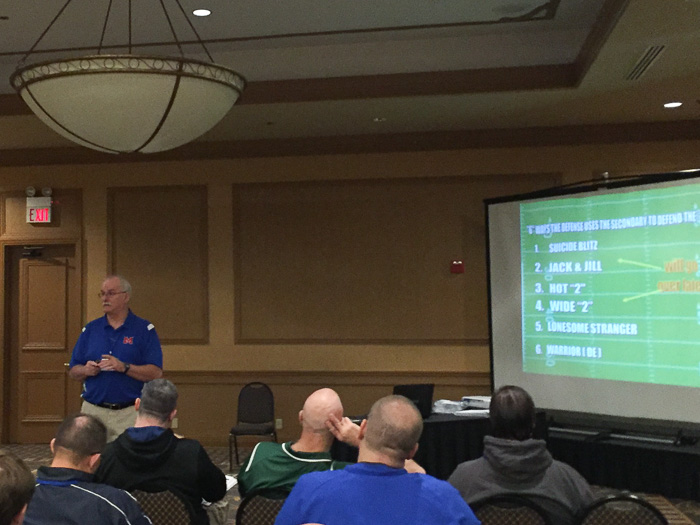Glen McNew’s Practice and Game Planning for the Wing-T

Coach Glen McNew ran a very interesting session at the National Wing-T Clinic in 2016 on practice planning and game preparation, specifically focused on the Wing-T. He is a legendary high school coach in West Virginia.

Choosing Your Wing-T Discipline
Glen started with an admonishment: choose your discipline of Wing-T and stick to it. Don’t dabble in more than 1 or 2 or you will lose focus and practice time. His key Wing-T disciplines include:
- Base Wing-T
- Shotgun
- Pistol
- Single Wing
- Double Wing
- Spin Series
- Auburn Series
Practice Approach
Coach McNew holds a practice every Saturday morning at 8am after the Friday night game, and if a player is a minute late he will not start the next game. Players that are injured get treated by trainer or referred on, and players will do basic running and stretching, bird dog blocking techniques, and watch some game film from the prior night.
His teams practice in shorts all the time. Practice pants cost time and money and he doesn’t see the added benefit. It also is consistent with their approach to contact management.
His teams do not watch opponent game film together as a team - this will be done in position specific groups with focus. He does test his players each week.
A normal weekday practice is 2 to 2.5 hours. Structure is:
- Pre-practice – Coach McNew advises coaches not to fall in love with their voice and give long speeches during this period.
- Calisthentics
- Conditioning (they do run)
- Walk throughs
- Special teams, and if you aren’t on special teams you will do Indy
- Indy
- Special teams, and if you aren’t on special teams you will do Indy
- Group
- Team
On Thursdays before the game they will go no huddle, with plays called from sideline just like in game, both offense and defense.
Examples of Their Indy Period
- Offensive Line – Will work on down block, fire block, double teams, and pass protection. Side Note – Coach McNew teaches the skip pull technique for his offensive linemen. The backside foot comes behind and across the front foot, and is used for outside running like buck sweep.
- Running Backs – Run blocking, patterns with the QB, plays with the QB, pass blocking
- Wide Receivers – Routes on air, stalk block, releases, crack block.
Game Planning
Glen then went into a detailed example of how he approaches game planning. The first question he asks is How are they defending D gap? He likes to work outside then inside, as he believes attacking the flank is a key component of the Wing-T offense. His D gap plays include:
- Buck Sweep
- Belly Sweep
- Down Sweep
- Jet Sweep
- Rocket Sweep
- Waggle
He relies on the Belly and Down sweep plays as a no-motion alternative flank play. I haven’t looked at his film, but this implies that he might run a lot from a double wing set.
Buck Sweep
Coach McNew commented “I’m gonna run buck sweep till the cows come home,” which may seem like over dedication to a single play. The truth is he is invested in the buck series and has an intense focus on alternate formation looks and blocking schemes to ensure that he can make this play work.
He always reaches his C to playside when running buck sweep, filling behind with the FB on the fake guard trap. He will spread the formation out if the defense puts 9 or 10 in the box, but still run buck sweep. He also utilizes trades (flipping TE), switches (such as tackle over), and flipping backfield.
If a stud defensive end is shutting down buck sweep (usually because the WB cannot block him), run down or power at him, kicking him out with a tighter trap from the guard or FB. Then when he starts to squeeze, go back to running buck sweep.
Evaluating Secondary Involvement in Run Game
Glen spent a lot of time on a sample analysis of defensive secondaries vs. the Wing-T, sharing a few things defenses will do to disrupt the run game along with counters.
- Suicide Corner Blitz – When the playside corner is blitzing the TE side, consider running with the WR over the TE to spread the CB further out and force coverage. Or shift to shotgun / trey for a similar effect. Run Down Sweep and try to get the CB to close on the FB, leaving the flank open.
- Jack and Jill – If you have a free safety coming downhill fast to defeat the run, consider putting the WR over the TE and having him crack on the FS. Glen will even substitute a backup FB in for the WR.
- Wide Outside LB - The OLB (or could be a safety in a 4–2–5) is playing wide at 5 yards, 3 yards depth. They will make an alert call and the playside guard will use his skip pull technique to get wider and kick him out.
Call Sheet Organization
Coach McNew organizes his game time call sheet as follows:
- Formations
- Shifts
- Plays by gap
- 6–8 run plays
- 4–5 pass plays
- 1 trick play
- 1 2-point conversion play
- 1 win-it-all play (hail mary)
Overall this was a great talk, and underscored a theme I’m hearing from many coaches: run fewer plays, but work on wrinkles to make the plays you do run perform better. Additionally, once in the season practice them against the defense you will see and account for likely variations.